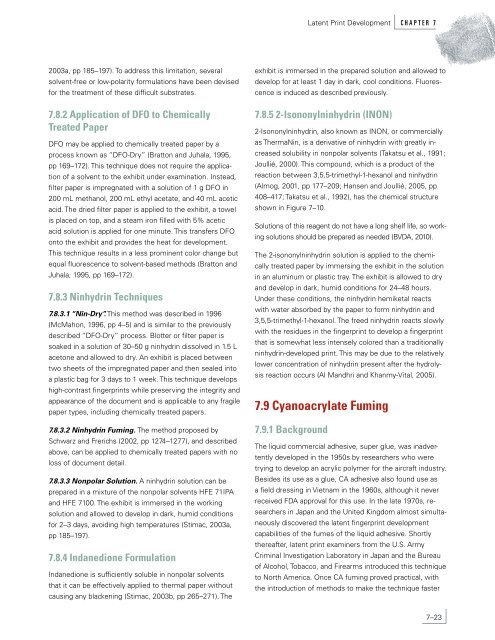Latent Print Development - National Criminal Justice Reference ...
Latent Print Development - National Criminal Justice Reference ...
Latent Print Development - National Criminal Justice Reference ...
You also want an ePaper? Increase the reach of your titles
YUMPU automatically turns print PDFs into web optimized ePapers that Google loves.
2003a, pp 185–197). To address this limitation, several<br />
solvent-free or low-polarity formulations have been devised<br />
for the treatment of these difficult substrates.<br />
7.8.2 Application of DFO to Chemically<br />
Treated Paper<br />
DFO may be applied to chemically treated paper by a<br />
process known as “DFO-Dry” (Bratton and Juhala, 1995,<br />
pp 169–172). This technique does not require the application<br />
of a solvent to the exhibit under examination. Instead,<br />
filter paper is impregnated with a solution of 1 g DFO in<br />
200 mL methanol, 200 mL ethyl acetate, and 40 mL acetic<br />
acid. The dried filter paper is applied to the exhibit, a towel<br />
is placed on top, and a steam iron filled with 5% acetic<br />
acid solution is applied for one minute. This transfers DFO<br />
onto the exhibit and provides the heat for development.<br />
This technique results in a less prominent color change but<br />
equal fluorescence to solvent-based methods (Bratton and<br />
Juhala, 1995, pp 169–172).<br />
7.8.3 Ninhydrin Techniques<br />
7.8.3.1 “Nin-Dry”. This method was described in 1996<br />
(McMahon, 1996, pp 4–5) and is similar to the previously<br />
described “DFO-Dry” process. Blotter or filter paper is<br />
soaked in a solution of 30–50 g ninhydrin dissolved in 1.5 L<br />
acetone and allowed to dry. An exhibit is placed between<br />
two sheets of the impregnated paper and then sealed into<br />
a plastic bag for 3 days to 1 week. This technique develops<br />
high-contrast fingerprints while preserving the integrity and<br />
appearance of the document and is applicable to any fragile<br />
paper types, including chemically treated papers.<br />
7.8.3.2 Ninhydrin Fuming. The method proposed by<br />
Schwarz and Frerichs (2002, pp 1274–1277), and described<br />
above, can be applied to chemically treated papers with no<br />
loss of document detail.<br />
7.8.3.3 Nonpolar Solution. A ninhydrin solution can be<br />
prepared in a mixture of the nonpolar solvents HFE 71IPA<br />
and HFE 7100. The exhibit is immersed in the working<br />
solution and allowed to develop in dark, humid conditions<br />
for 2–3 days, avoiding high temperatures (Stimac, 2003a,<br />
pp 185–197).<br />
7.8.4 Indanedione Formulation<br />
Indanedione is sufficiently soluble in nonpolar solvents<br />
that it can be effectively applied to thermal paper without<br />
causing any blackening (Stimac, 2003b, pp 265–271). The<br />
exhibit is immersed in the prepared solution and allowed to<br />
develop for at least 1 day in dark, cool conditions. Fluorescence<br />
is induced as described previously.<br />
7.8.5 2-Isononylninhydrin (INON)<br />
2-Isononylninhydrin, also known as INON, or commercially<br />
as ThermaNin, is a derivative of ninhydrin with greatly increased<br />
solubility in nonpolar solvents (Takatsu et al., 1991;<br />
Joullié, 2000). This compound, which is a product of the<br />
reaction between 3,5,5-trimethyl-1-hexanol and ninhydrin<br />
(Almog, 2001, pp 177–209; Hansen and Joullié, 2005, pp<br />
408–417; Takatsu et al., 1992), has the chemical structure<br />
shown in Figure 7–10.<br />
Solutions of this reagent do not have a long shelf life, so working<br />
solutions should be prepared as needed (BVDA, 2010).<br />
The 2-isononylninhydrin solution is applied to the chemically<br />
treated paper by immersing the exhibit in the solution<br />
in an aluminum or plastic tray. The exhibit is allowed to dry<br />
and develop in dark, humid conditions for 24–48 hours.<br />
Under these conditions, the ninhydrin hemiketal reacts<br />
with water absorbed by the paper to form ninhydrin and<br />
3,5,5-trimethyl-1-hexanol. The freed ninhydrin reacts slowly<br />
with the residues in the fingerprint to develop a fingerprint<br />
that is somewhat less intensely colored than a traditionally<br />
ninhydrin-developed print. This may be due to the relatively<br />
lower concentration of ninhydrin present after the hydrolysis<br />
reaction occurs (Al Mandhri and Khanmy-Vital, 2005).<br />
7.9 Cyanoacrylate Fuming<br />
7.9.1 Background<br />
<strong>Latent</strong> <strong>Print</strong> <strong>Development</strong> C H A P T E R 7<br />
The liquid commercial adhesive, super glue, was inadvertently<br />
developed in the 1950s by researchers who were<br />
trying to develop an acrylic polymer for the aircraft industry.<br />
Besides its use as a glue, CA adhesive also found use as<br />
a field dressing in Vietnam in the 1960s, although it never<br />
received FDA approval for this use. In the late 1970s, researchers<br />
in Japan and the United Kingdom almost simultaneously<br />
discovered the latent fingerprint development<br />
capabilities of the fumes of the liquid adhesive. Shortly<br />
thereafter, latent print examiners from the U.S. Army<br />
<strong>Criminal</strong> Investigation Laboratory in Japan and the Bureau<br />
of Alcohol, Tobacco, and Firearms introduced this technique<br />
to North America. Once CA fuming proved practical, with<br />
the introduction of methods to make the technique faster<br />
7–23

















